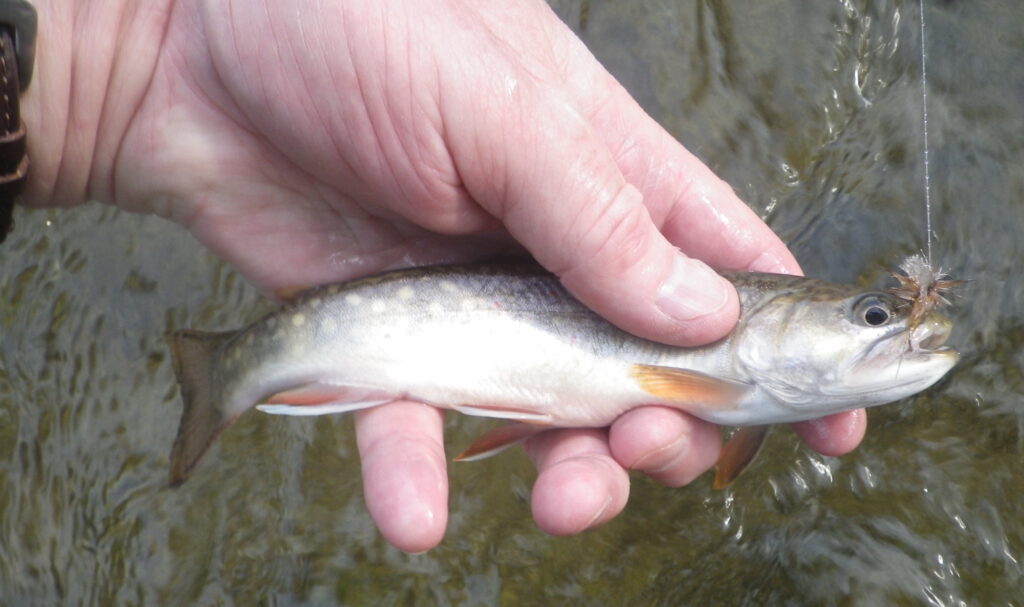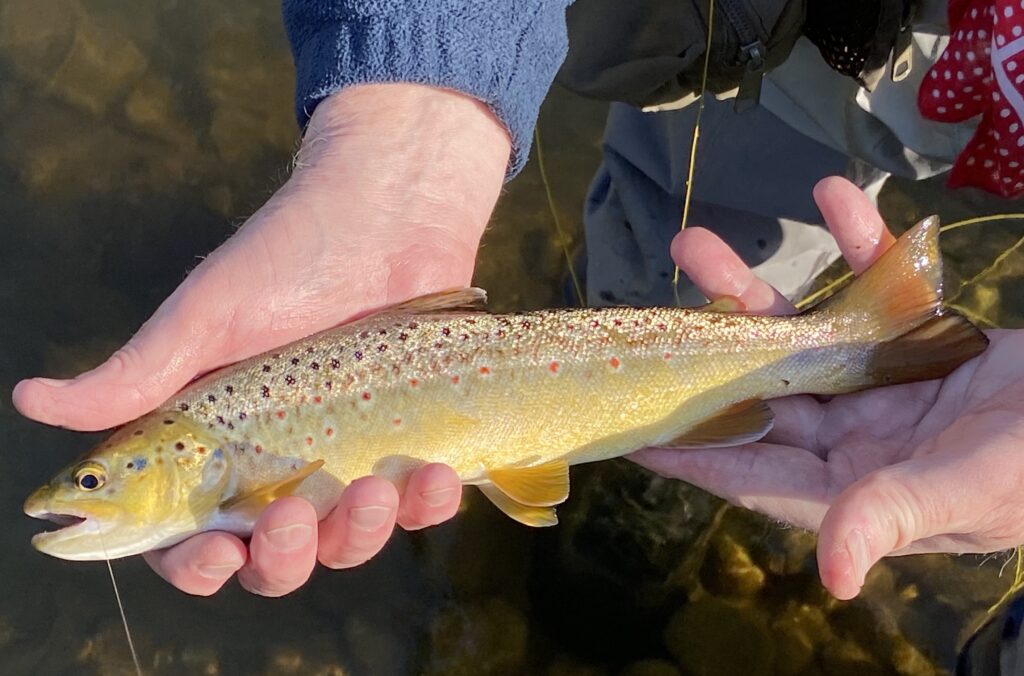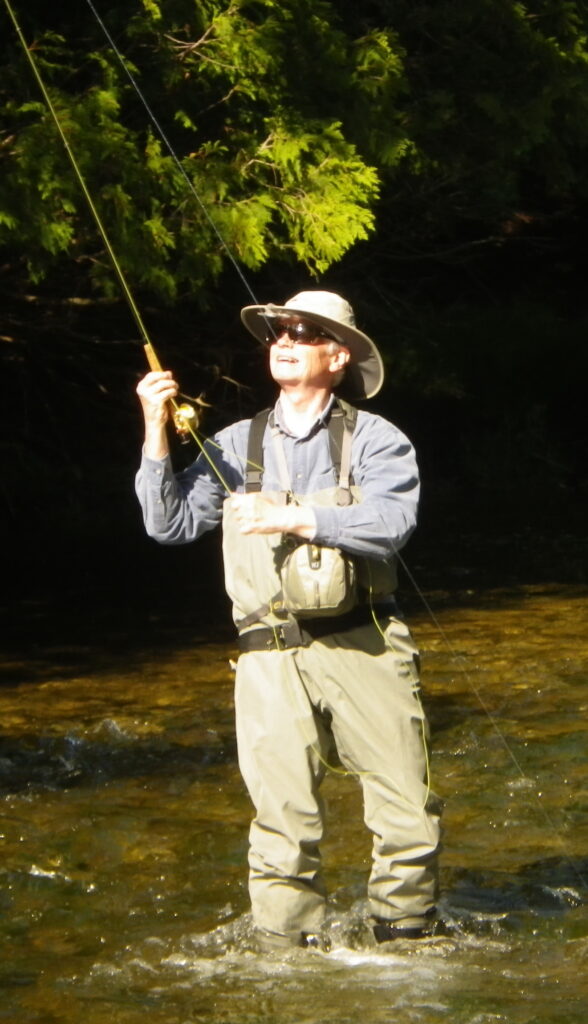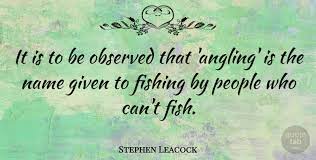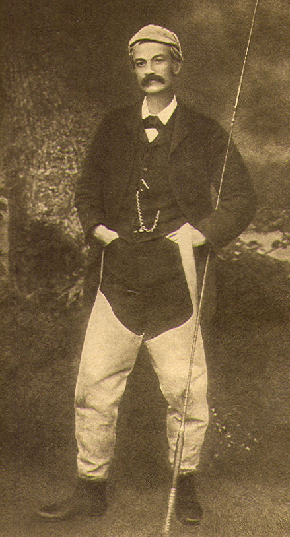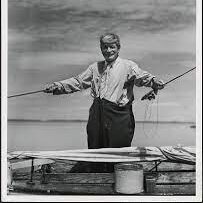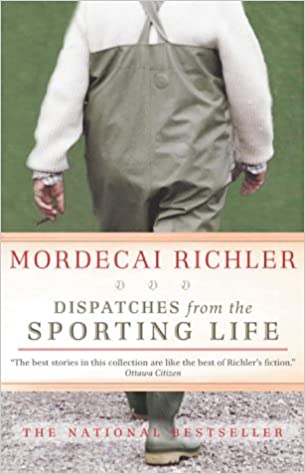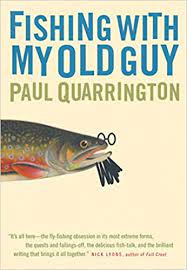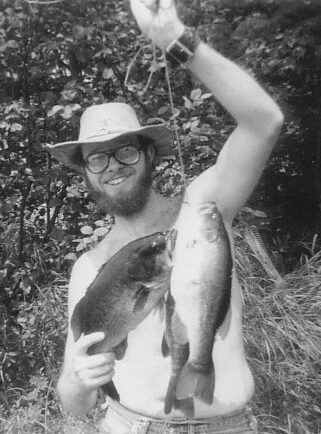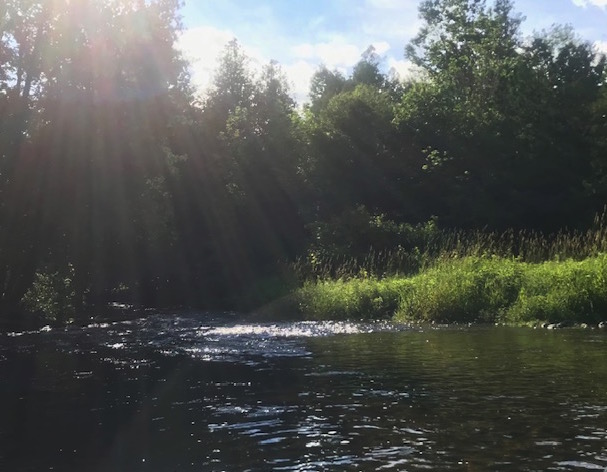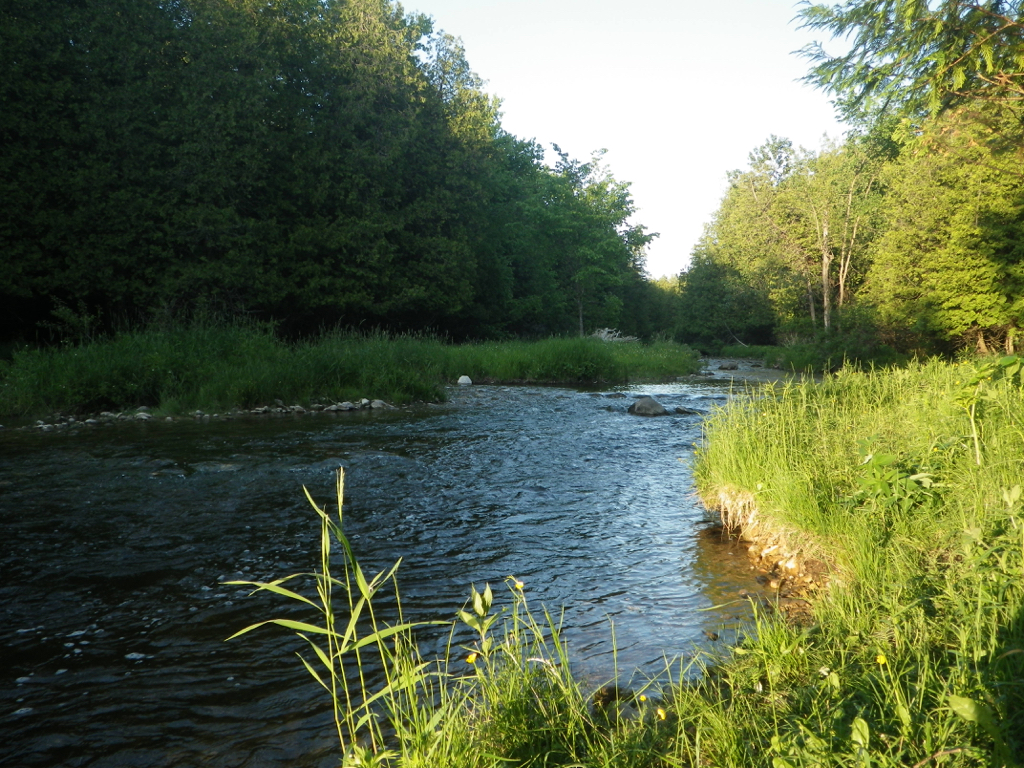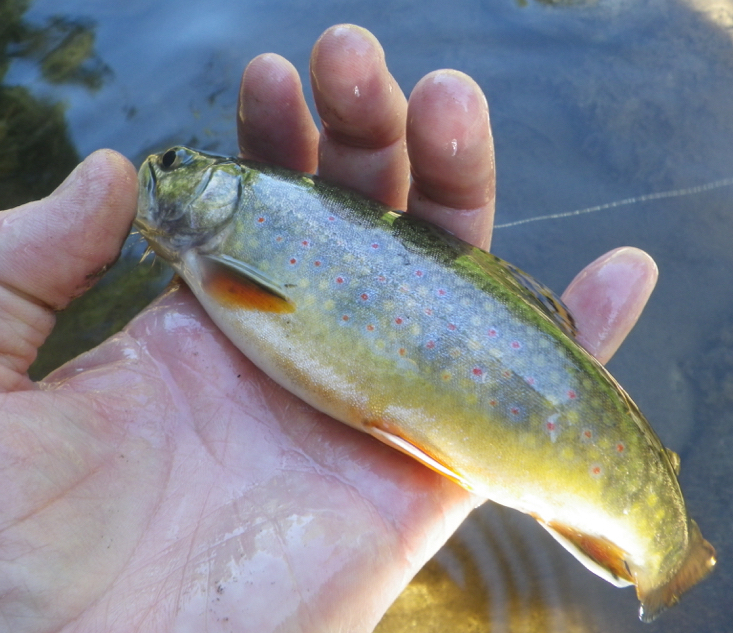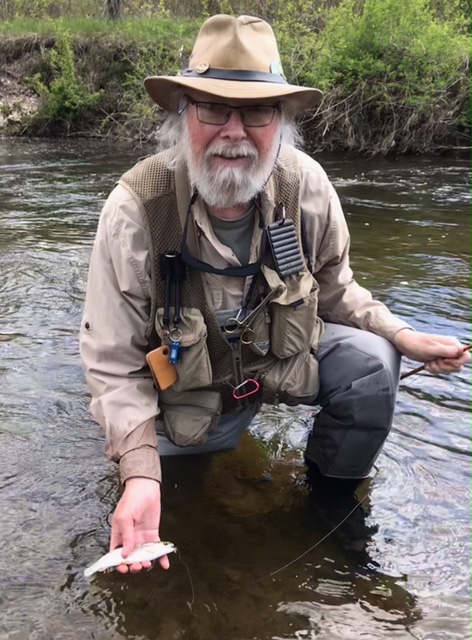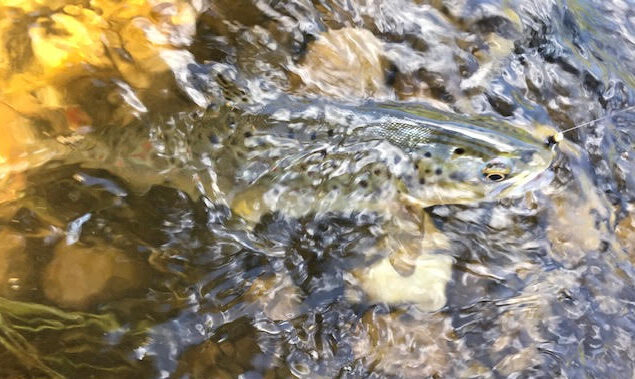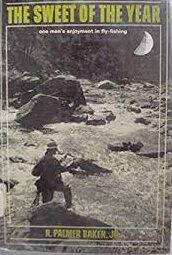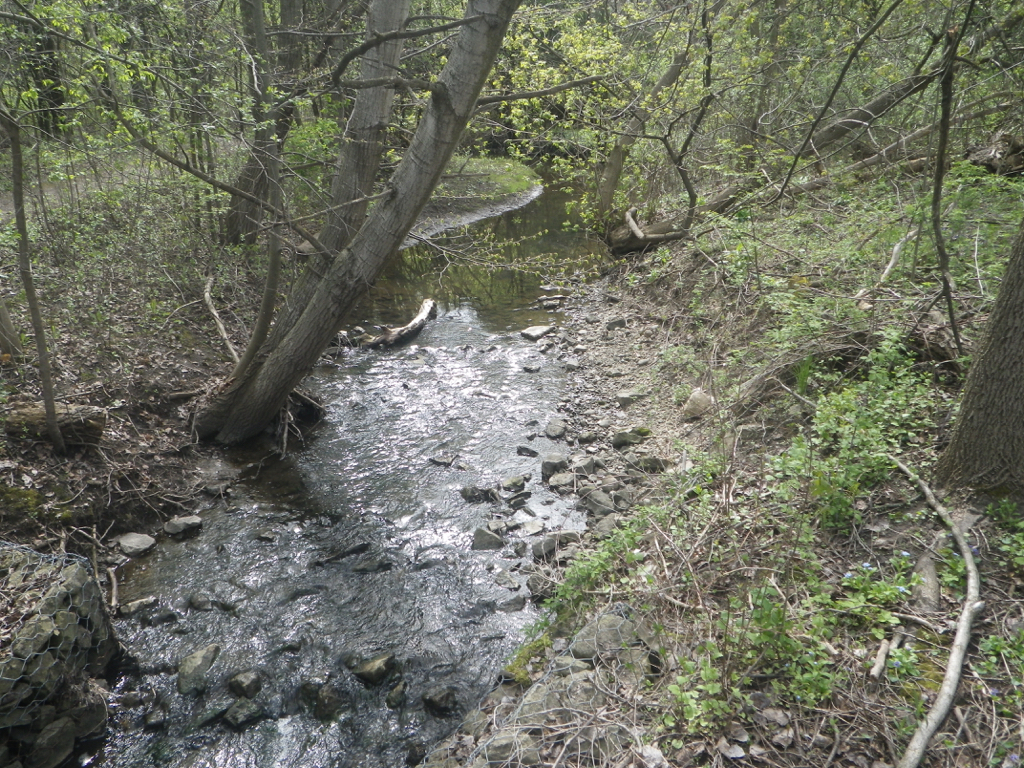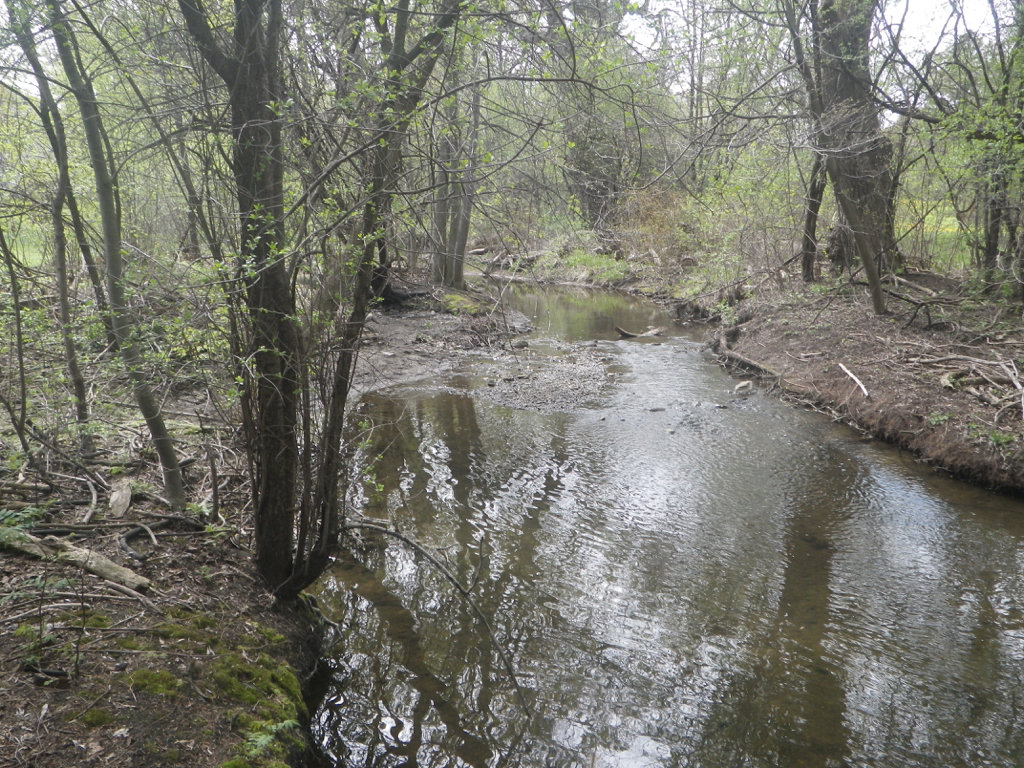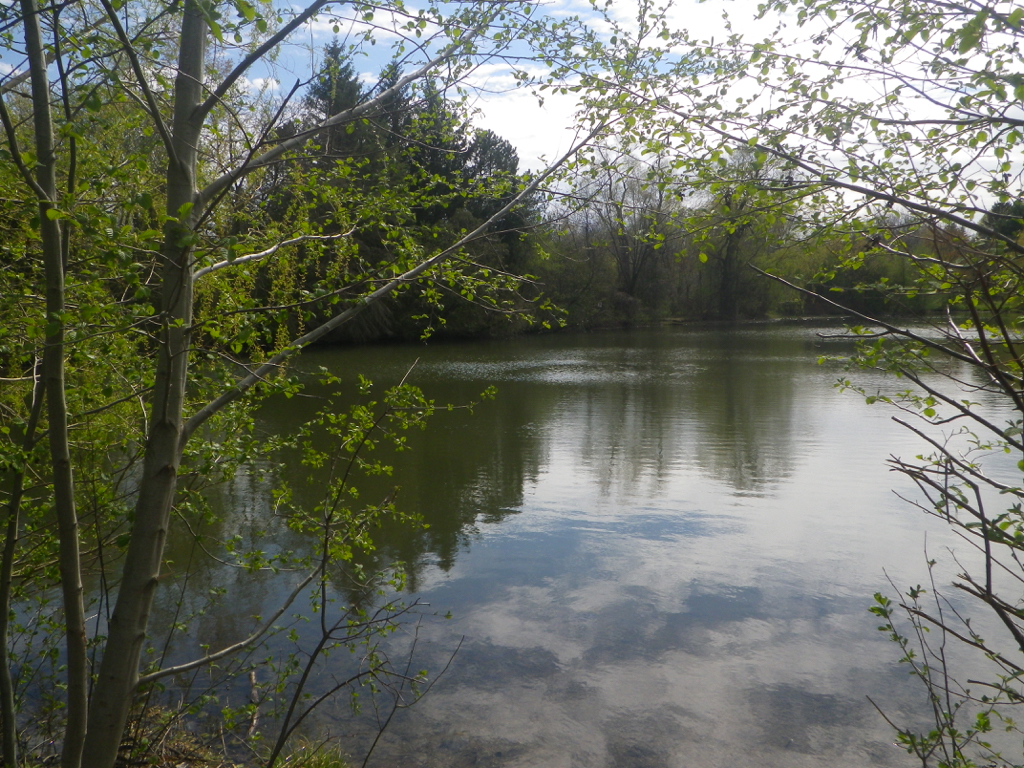The adage about good things coming to those who wait had not applied to me more directly than when I finally fly fished my hometown river. After all, it had taken me more than the Biblical ‘threescore years and ten’ to cast fur and feather on the Thames.
Originally known as Deshkan Ziibi (Antler River) in the Ojibwe language of the Anishinabek People and Neutrals prior to European contact, it was renamed in honour of England’s historic River Thames by John Graves Simcoe, first lieutenant governor of what was then known as Upper Canada. Although his tenure was brief, from 1791 until 1796, the former British Army general anglicized much of southwestern Ontario through a systematic program of naming and/or renaming–including my hometown of London.
I don’t have much of an opinion regarding Simcoe’s ambitious colonial agenda with two exceptions. Look at a map of the watershed’s web of headwaters and it becomes obvious that the Antler River is a superior name based on topography if nothing else.
Similarly, the Bruce Peninsula’s original name of the Saugeen Peninsula is better based on history and occupation. The Saugeen Ojibway Nation inhabited the area for more than 7,500 years, in contrast to James Bruce, the 8th Earl of Elgin (remembered as Lord Elgin), who was governor general of the Province of Canada for a blink of an Imperialist’s eye, from 1847 to 1854.
The Canadian Heritage River bisects southwestern Ontario while meandering 273 kilometres to Lake St. Clair. Its network of sources, which lie north and east of London, consist of three main tines or branches (north, middle and south). The north converges with the middle and south, which have already merged upriver, in the heart of the city at what is known as the Forks. The stately Middlesex County Court House–constructed over three years commencing in 1827 to resemble an English castle replete with Gothic trappings–and modernist steel-and-glass Museum London stand as vigilant sentinels over this proud municipal site, so rich in history and heritage.
The watershed was formerly enclosed in a dense Carolinian forest, much of which was cleared for agriculture and various forms of development. Steve Leslie, a dear friend who died much too young, referred to this part of Canada as its bellybutton, which has always struck me as an apt description.
As one of Canada’s most southern rivers, many of its aquatic species are not found anywhere else in the country. A number are designated species at risk. Still, it’s home to ninety species of fish spread throughout its multifarious stretches of river and three dammed lakes (Fanshawe, Wildwood and Pittock) which attract a range of anglers irrespective of gear and tackle, ethics and aesthetics.
These include brown, rainbow and brook trout (in cold spring-fed tributaries), smallmouth and largemouth bass, northern pike, walleye, redhorse, yellow perch, rock bass, pumpkinseed, bluegill, freshwater drum (also known as sheepshead), black and brown bullhead, Bigmouth Buffalo(fish), white sucker, longnose gar, channel catfish and common carp. When shad and quillbacks are running, muskies can also be found in pursuit of a hearty meal of baitfish.
I spent the first twenty-one years of my life within a few blocks of the Thames. Until I was ten it was an easy walk to one branch. During my late teens and early twenties I worked in an appliance factory, long since gone, that stretched for many blocks along its banks. Although I shudder to think of the toxins it dumped into the river over its century of operation, my mom’s side of the family formed a four-generation employment legacy. My great-grandfather, grandfather, mom Barbara and her sister, Aunt Pat, and her husband, Uncle Ivan, all worked there in addition to my brother Steve, cousin Brad and me. Familial nepotism was common in those bygone days.
For the remaining eleven years, before heading off to university, my family lived a couple of blocks from the Forks in London West (once known as Skunk’s Hollow). Our small bungalow was a baseball’s throw from Labatt Park, the longest continuously operating ballpark in the world which still bears the name of the homegrown brewery that was one of the city’s foundational employers before being sold to American interests. I crossed the Dundas Street Bridge almost every day for four years while attending high school at H.B. Beal (where I majored in mechanical drafting) and working part-time as a bellhop at a venerable downtown commercial establishment, the Hotel London.
When I was growing up in the 1960s and ’70s, the Thames, like many rivers throughout southern Ontario, was polluted beyond redemption and, therefore, uninviting to anglers. I can remember as a youth avoiding wet wading in what was roundly condemned as ‘an open sewer.’
Most of the fishing I did in my early years was not done on the Thames. Rather it formed an integral part of camping trips with my closest friend, Billy Everett, and his parents, Len and Selina. They were avid anglers (although Bill abandoned the activity in adulthood). What little fishing I did on the Thames, beyond city limits, was in the company of my dad or Uncle Ivan.
My dad, Bob, was naturally competitive but hardly aggressive. As a youngster he was accomplished enough on the accordion (a popular instrument at the time, before it was turned into a relic by the electric guitar in the 1960s) to regale students at public school assemblies. Teachers fondly remembered his performances years later. As a teenager he was a Yo-Yo champion who toured southwestern Ontario. I remember being amazed into a stupor when he did tricks for my brother Steve, sister Brenda and me. Both he and mom were above average recreational bowlers.
From his youth, through adulthood, to his maturity, the thing that gave my dad the most intense pleasure was dancing, whether at the annual Fireman’s Ball, end-of-season bowling and baseball parties or family weddings. Regardless of the occasion it wasn’t long before his suit jacket and tie were discarded; he usually took an extra shirt so he could change sometime during the evening. And he wasn’t done until he had danced with every woman at the event, saving the last dance for mom.
Dad was a career firefighter. While he loved sports—he coached championship fastball and basketball teams and was a fan of all major league sports—he had no interest in hunting and fishing; golf was his great enthusiasm, which I did not share. Still, I remember him taking me to the Thames a few times when I was young. I’m sure he drilled colleagues at work who were outdoorsmen about promising locations which rarely fulfilled youthful expectation.
Uncle Ivan, who was born and raised on a farm, fished before marrying Aunt Pat. He once travelled by train to James Bay, which I revered as the height of angling adventure. He died of complications from congenital heart disease while still in his early forties, a condition that was unfortunately passed down to his son Brad. Uncle Ivan—a quiet, reserved, creative, deeply intelligent man whose wry sense of humour was reflected in his love of the British comedy troupe Monty Python–bequeathed me his fishing tackle and .22 rifle.
I especially cherished the latter because he had replaced its original stock with one he handmade out of Honduran mahogany. I oiled it religiously to nourish its rich reddish-brown lustre. In Grade 8 woodworking class I made a gun rack, first for my BB gun and pellet rifle, and later for my .22 and twelve-gauge, pump Winchester shotgun purchased with my bellhop wages and tips.
Later, I fished the Thames with my Uncle Jim, who had a vintage sixteen-foot cedar strip boat with a stubborn Johnson outboard motor, and his brother, my Uncle Doug.
In Lines on the Water, the memoir that has influenced my own angling writing more than any other book, David Adams Richards confides that his father wasn’t a fisherman. Fortunately, when he was young and eager he found a teacher, a mentor, a wise old fisherman. Alvin Simms (no relation to the waders manufacturer) was a solitary neighbour who worked in the woods during the winter and lived in a tent during the summer. Still, he taught the neophyte angler the ways of fish and fishing, not to mention the infinitely more perplexing ways of men.
Richards pays his teacher the ultimate compliment when he writes that Simms was ‘as unconsciously a part of the river as any man’ with whom he had ever fished.
While I’m thankful to have had adults who took me fishing throughout my youth, in my most formative years I did not find a teacher or mentor, even though there was someone who could have played the role—if only I had mustered the gumption to request his guidance and wisdom. I knew him as Uncle Tony, despite not being related by blood.
Tony Molino was a middle-aged widower when I met him through the Everetts. Uncle Tony’s landlord, Ruth, was a close friend of Selina’s and I often tagged along when they visited Ruth and Tony on Saturday nights to watch the Toronto Maple Leafs on Hockey Night in Canada—in those distant days a ‘sacred’ national ritual.
As it turned out, my dad had known Tony for many years, having worked together—along with entertainment legend Gordie Tapp (Country Hoedown in Canada and Hee Haw in the U.S.)–at the renowned Scott McHale shoe factory. Tony–who attended public school with the famous musical Lombardo Brothers (Guy Lombardo and his Royal Canadians provided the orchestral backdrop to New Years’ celebrations for years)–was the only one of the three who remained there until retirement.
Because of his deliberate quiet manner, horn-rimmed glasses and grey hair parted down the middle of his head, Uncle Tony seemed quintessentially old, even though he was in his fifties when I would have benefited most from his arcane knowledge of fishing. People said he could ‘smell’ fish. Whether he targeted bass, pike or any other game species, it didn’t matter. He always caught fish. Whenever he joined us on a day’s outing he would invariably venture off by himself with his trusty bait-casting rod and precious tackle box. Uncle Tony epitomized solitary angling.
I now know through the piscatorial classroom of trial and error that Uncle Tony ‘read’ the water, even if I can’t recall him ever opening an instructional fishing book or perusing a popular outdoor magazine of the day like Field and Stream. Rather he gained his ‘fish sense’ through experience and close observation, fortified with a powerful dose of natural intuition—or maybe even predatory instinct.
When he wasn’t casting from some lone riverbank, Uncle Tony was warm and gregarious. He never declined an invitation to a party. Whether in a kitchen or parlour, on a porch or around a campfire, he was at the centre of festivities, strumming on his pint-sized, four-stringed banjo-ukulele with the index finger of his right hand while drawing on a vast repertoire of popular songs from the 1920s, ‘30s and ’40s. A light drinker and a hearty eater, he derived his greatest pleasure—when he wasn’t fishing–from the shared communal merriment of song.
. . . . .
The world of fly angling is a fecund garden of aquatic delights, which for most of us is both interesting and rewarding. Talk to a fellow fly angler for the first time and, before long, you’re merrily sharing mutual connections and associations, if not confidences.
I reconnected with Doug Kirton a few years ago, when I emailed him to inquire about donating some etchings to the University of Waterloo Art Gallery. He mentioned he was thinking about retiring from teaching, adding that he was toying with the idea of taking up fly fishing after reading my memoir Casting into Mystery. I encouraged him to follow his bliss and suggested we get together the following spring for some basic casting instruction.
I had last talked to Doug about fifteen years previously for a newspaper review I wrote on an exhibition the Kitchener Waterloo Art Gallery mounted after he had been hired a few years earlier by the University of Waterloo. Having completed a bachelor’s degree from the Nova Scotia College of Art & Design and a masters in fine art from the University of Guelph, he became an associate professor, eventually being appointed chairman of the fine arts department.
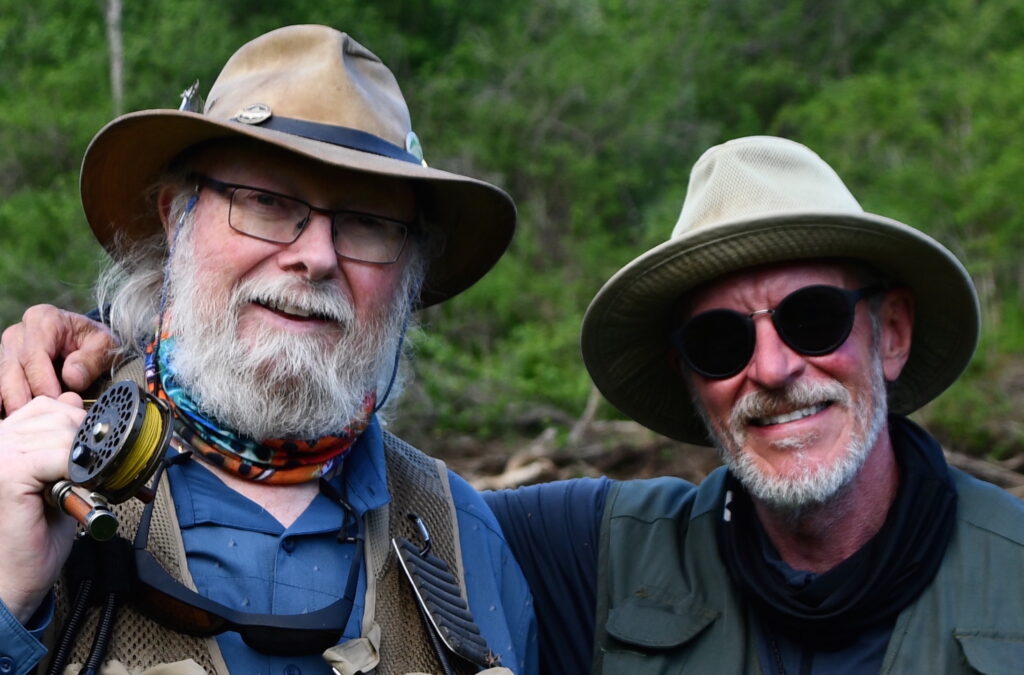
Doug has always maintained a studio in addition to teaching and he continues to balance a range of outdoor activities with a busy art practice. His recent work–which is represented by London’s Michael Gibson Gallery–explores the natural and social landscapes—a conversation he has been conducting with himself on canvas for forty years. Fly fishing has since become a persistent voice in that engaging visual discussion.
I was delighted to reconnect with Doug. Not only had we grown up in the same neighbourhood, we also went to the same elementary school. Empress Avenue Public School–which my dad and his brothers and sisters attended before Steve, Brenda and me–is long gone. Four years younger than me, Doug and Steve were classmates. Doug remembers me coaching him and Steve softball when I was a wily fourteen-year-old veteran in Grade 8 and they were aspiring ten-year-old infielders in Grade 5.
When we met up for a couple of hours of lawn-casting, he mused, ‘Just think, when we were kids you coached me baseball, now you’re coaching me fly fishing.’
Since then, we have become regular angling companions, mostly for brown trout on the Grand River tailwater and for smallmouth bass on the middle Grand. Doug has been a quick, eager and willing learn. Like most accomplished artists, regardless of field or discipline, he possesses a creative drive that’s equally obsessive and compulsive. All of which makes his enthusiasm intense and infectious. I thought of Doug when I read Rick Bass’s description of Russell Chatham in The Traveling Feast when he writes, ‘His deepest vice is fishing; other than painting, it’s his greatest obsession. . . .’
Upon reflection I think Doug approaches fly fishing as he approaches painting. Irrespective of subject, whether urban or natural, as an artist he must exert or impose his creative will in order to transform and transfigure reality into created image. Interestingly, I think this is what competitive anglers have to do, whether participating in America-style bass tournaments or English-style match fishing. Of course, fly fishing is not exempt from competitions.
I suspect Doug has adopted this approach to fly fishing through long habit, and success, in his art practice, coupled with the fact that he came to fly fishing only a few brief years ago and, therefore, brims with youthful enthusiasm that belies his years. (Good on him!)
In contrast, I have come to approach fly fishing with less will and more acceptance–going with flow, to repeat a hackneyed cliche. When you focus on outcome, as painters and competitive anglers do, success is determined solely by quantitative results. As a recreational fly angler confronting the reality of abbreviated days on the water, this doesn’t work. This is not a value judgment, but a recognition that there are alternate ways of viewing and responding to fly fishing. It’s dependent on an angler’s personal definition of bliss. Is fly fishing sport or recreation, active or contemplative? This question has caused debate among fly anglers since Sir Izaak Walton raised the issue. There is no right or final answer.
What Doug doesn’t pick up on the water, he learns through power reading books, magazines and websites and viewing YouTube videos. My curmudgeonly ‘coaching’ includes reminding Doug to simplify what he has gleaned from fly angling professionals, some of whom have a stake in selling gear and tackle. This is a constant source of amusement between us, which gobbles up large chunks of amiable conversation en route to angling destinations.
I did not come to fly fishing until my fifties. Doug resisted the contemplative recreation until his sixties. Like many fisherman we transitioned from spinning rods and hard lures. So we’re both proof that old anglers can learn new tricks and that it is better late than never to cast a fly line on the water. If this makes us cliches in chest waders, so be it. Without fly fishing we would not have reconnected and our lives would have been equally reduced.
. . . . .
Throughout my youth I fished the Thames variously with bait-casting (the backlashes and bird’s nests still disrupt my slumber), spin-casting and open-faced spinning rods. I didn’t use a fly rod until a couple of weeks after my seventy-second birthday, as southwestern Ontario was slowly ascending the summit of summer.
I first raised the possibility of fishing my hometown river with Paul Noble a couple of years earlier, but our conflicting angling schedules foiled our best intentions. I had met him when he gave a presentation on angling opportunities afforded by the Thames for KW Flyfishers. I had suggested the topic to the executive–with an ulterior motive. I wanted to fish the river with someone intimately familiar with its character, moods and quirks, so I could then write about the experience. Fortunately, club member Steve May suggested Paul to President Dan Kennaley who, in turn, contacted and offered Paul an invitation.
Southwestern Ontario had weathered some serious rainfall, replete with thunderstorms and hail, during the week leading up to the Sunday Paul and I had arranged to meet for an evening’s fishing. Despite a forecast of thunderstorms through the afternoon into late night, we stuck to our rods, so to speak.
After enjoying supper at the Malibu Restaurant, a traditional family eatery that has been serving home-cooked meals in East London for many decades, we headed to the Thames. We went together in my Jeep because Paul’s Jeep blew an engine a few weeks previously when he and some buddies were on their annual fishing trip to the North Shore of Lake Superior—celebrated universally as an angling paradise.
On the way I quizzed Paul about his sporting life—like all old newspapermen my interviewing impulses have not dimmed.
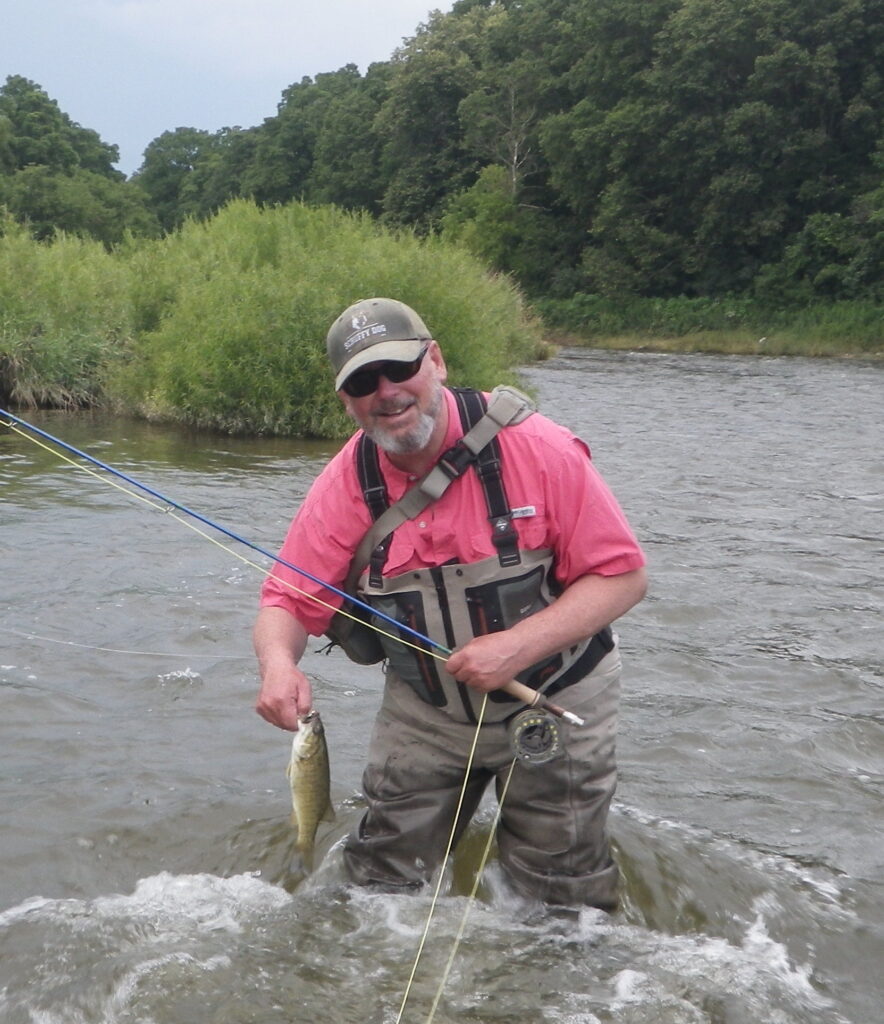
Born and raised in London, Paul attended H.B. Beal’s acclaimed BealArt (a decade after I graduated) before attending the Ontario College of Art. His parents were inveterate recreational campers so his love of the outdoors came honestly and has neither faltered nor faded.
He started spin fishing under his father’s guidance when he was in elementary school; by his early teens he had taken up the fly rod, which means he’s been casting artificial flies to game fish for half a century. He has been a keen hunter equally as long for turkey (with bow and arrow as well as shotgun), deer, rabbit, squirrel and upland birds.
Paul belongs to numerous outdoor organizations including Thames River Anglers Association, Western Ontario Fish & Game Protective Association, Forest City Fly Fishing Club and Crumlin Sportsmen’s Association. He is also a member of Ontario Federation of Anglers & Hunters and KW Flyfishers.
He plays an active part in the Anglers Association’s operation of a trout hatchery, with browns in late fall and rainbows in spring. It also raised brookies until the program was cancelled after donor streams started developing self-sustaining populations.
Paul is a passionate conservationist as well as a sportsman. He was part of a small group of Angling Association members who, with the support of concerned citizens including First Nations’ representatives, lobbied city council to decommission the controversial Springbank Dam in west London. Since its removal in 2019, populations of native fish and aquatic species have increased, as expected.
One of Paul’s closest fishing companions was the late Ian Colin James who lived in London for many years. Before his untimely death, Ian had become one of Canada’s most prominent fly anglers through the allure of his personality as well as his angling prowess. Paul cameoed in Ian’s entertaining memoir Fumbling with a Flyrod.
Thirty minutes after leaving the restaurant we arrived at a spot northeast of the city that local anglers celebrate as the most scenic stretch of the Thames. Getting to the river was tricky and it took some slogging because of the outgrowth of shoulder-high vegetation including stinging nettles and toxic giant hogweed. Although I have a general idea of where we were, I’ll never be able to find my way back without Paul’s guidance. He lived in a house overlooking the road from which we accessed the river for twenty years, so knows the area like the back of his casting hand.
By the time we made it to the river it looked like we were going to get soaked. Dark menacing thunderheads approached from the west; however, they circumvented us without a peep or a drop. More significantly, the threat of foul weather triggered the bite. Later Paul observed that the fishery was prone to ‘turning off and on like a light switch.’ And, as we were about to discover, the piscatorial switch was definitely ON.
We entered the river at a lengthy riffle and made a few casts to find our rhythms—at least I did. Then Paul suggested we mosey down to the tail of the riffle. ‘It’s usually a hot spot,’ he noted.
Talk about understatement. After he advised me to stop—perhaps ordered is the more accurate word–I made my first deliberate cast.
Kapow.
I was into my first fish–a good ‘un’.
Even acknowledging the effect of the current, I wrestled with the tumbling, brawling, broad-shouldered brute for a good ten minutes, at least. The weight-forward, floating fly line was as taut as piano wire. It felt like a steelhead or carp. Or an old rubber boot. After I wrenched it out of the current, it torpedoed for the weeds nestled alongside the riverbank and, in the process, won my admiration for its stamina, perseverance and creativity.
It was a smallmouth bass. Long celebrated, pound for pound, as one of the world’s great fighting fish regardless weight classification. It was a handsome mottled greenish-bronze with dark vertical bars running down its sides, a reminder of its pedigree as a proud member of the sunfish family.
I played it longer than I had ever played a bass–in river or lake. It was a tug-of-war on the water; give and take with me surrendering most of the give. The struggle gave my throbbing, arcing eight-and-a-half-foot Winston five-weight a vigorous workout.
To cut to the figurative creel, I caught three feisty smallies on my first four casts. But, hey, who’s counting? The first was a healthy fourteen inches, one of three I landed of at least that length out of the eleven I caught. For his part, Paul caught ten, the largest an impressive eighteen inches.
On three occasions Paul and I landed double-headers, amid joyous squeals of delight. I tried to get a snapshot of him a couple of times but couldn’t get my camera out of my shoulder bag due to a rapacious smallie striking my Full-Motion Hex, one of my go-to bass streamers invented and tied by Steve May. It has everything I admire in a fly–lethal beauty, without contradiction. And, happily, discerning bass share my taste.
I checked the beguiling blonde Hex repeatedly and, although the dressing was frayed and the hook was twisted out of shape, I continued using it, fearful that changing flies might break the spell. Like eccentric hockey goalies, fly anglers are superstitious critters. Moreover, there’s few things more satisfying than retiring a battle-scarred fly that has served with distinction.
When it comes to hard lures a Rapala is just a Rapala. In contrast, every tattered and battered handmade fly becomes a memory word on which stories are built–whether a fish tale recalled over a pint or a dram, an anecdote recollected among companions in front of a hearth or around a campfire or, more formally, a poem, a prose vignette, short story, novel or memoir. I knew before I left the Thames that this fly would be a foundational brick on which to erect something lasting.
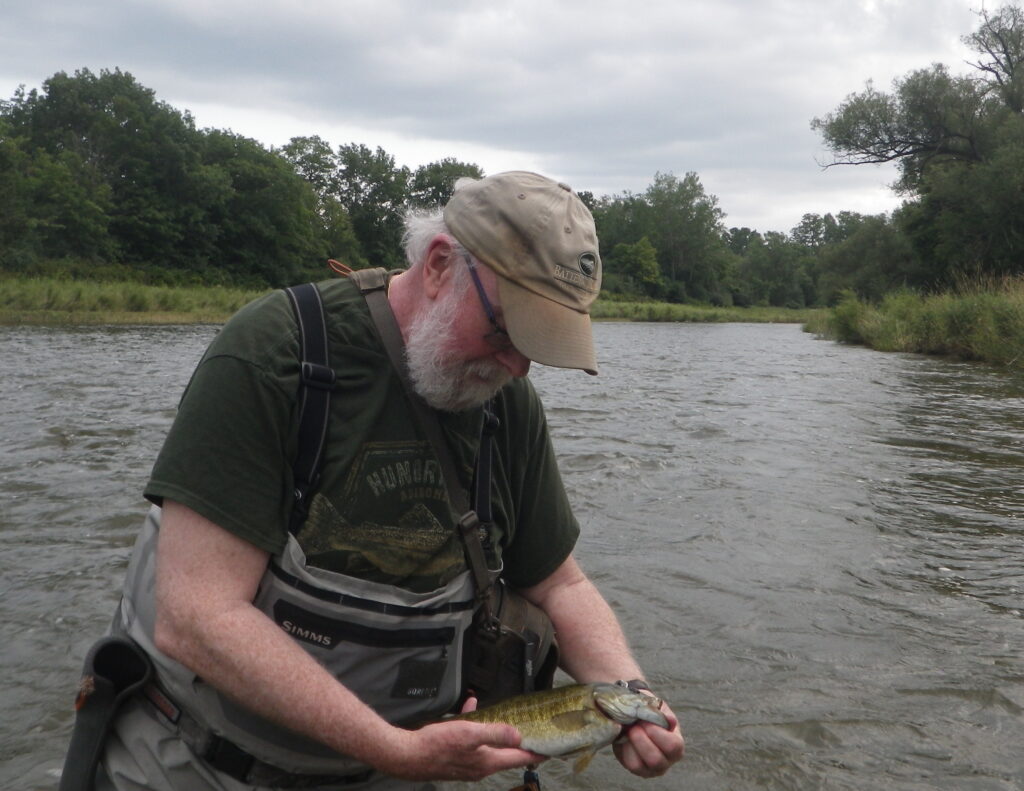
It was crazy fun. We were acting like kids in a school yard during spring recess after a long cold winter.
‘The catching is getting in the way of fishing,’ a grieving Paul feigned.
It might have been my best river bassin’–ever. I’ve caught more bass on the Grand River–which after twenty years I call my home water–in a single outing. Landing somewhere between sixteen and thirty smallies might not be routine, but it’s not unusual either. But never have I caught so many over a foot long.
Throughout the frenzy we caught our fish in a couple of metres of water while standing within thirty paces of one another. Paul caught fish that were almost at my feet.
‘The bass are using you as structure,’ he chirped.
After ninety minutes of piscine nirvana the bite stopped as suddenly and unexpectedly as it had begun, just as Paul had predicted.
‘We can’t stop at ten apiece,’ he said. ‘One of us must catch one more. Let’s give it another ten minutes.’
As if to balance some kind of natural scale, Paul’s last fish was his biggest, whereas my last one was my smallest, pushing the tape measure to six inches—barely.
Did I mention the beautiful scenery? Scanning the riverscape, ribboned with assorted deciduous trees and conifers of every imaginable hue of green, we could have easily been ‘Five Hundred Miles’ (to quote the popular folk song) from a city of nearly half a million people instead of a few kilometres. We were joined by an osprey and a heron, suggesting that this smallmouth harem (the biggest bass are female) wasn’t exactly a secret.
The angling muse willing, I hope to fly fish my hometown river again. I would love to catch a brown, rainbow or brookie, a prospect that was inconceivable when I was a youngster growing up in the Forest City.
Should I never fly fish the Thames River again, I will remember this occasion in the shadow of my seventy-second birthday as a tribute to all those I loved who played a role in introducing me to my hometown river. Or, as the late, great London poet James Reaney wished of his hometown river in ‘To the Avon River above Stratford, Canada’:
‘To flow like you.’
